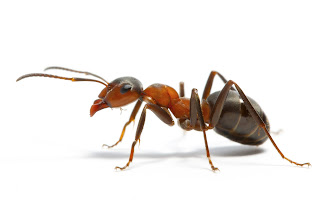Ants are insects and like all insects have three body parts: head,
thorax, and abdomen. Ants have six legs, which are covered with tiny
hairs. These hairs are used to clean its two antennae. The antennae are
used for touching and smelling. Ants' poorly developed eyes make these
sensory organs all the more important. Myrmecologists contend that ants
have a very elaborate communication system. For example, when ants
locate food, they create a scent path with a chemical substance from the
food to the nest, allowing other ants to travel from the nest and
locate the food. Ants also touch each other's antennae to communicate.
Ants live in colonies. Each colony consists of a queen, workers,
soldiers, and male ants. Ants build many different types of homes. Many
ants build simple mounds of dirt or sand. Other ants use small sticks
mixed with dirt and sand, which makes a stronger mound that offers
protection from rain. Ant mounds consist of many chambers connected by
tunnels. Different chambers are used for nurseries, food storage, and
resting places for the worker ants. Ants are found in almost all
terrestrial habitats, with the exception of high altitudes and
latitudes. Most ant species live in the soil, although some ants live in
wood, like termites. Army ants do not make a home at all, but travel in
large groups searching for food.
Physical Characteristics of Ants
Ant coloration can be black, earth-tone reds, pale tans, and basic
browns. Ant larvae are white and grublike. They have no legs and do not
move about much on their own. Their large, dark stomachs can generally
be seen through their cuticles. Ant pupae look like white adult ants,
with their legs and antennae pressed close to their bodies. In some
species, larvae spin silk, and the pupal stage is inside a cocoon. Newly
emerged adult ants are often paler than older ones. Without wings, a
male can generally be distinguished from a worker by the larger size of
his body, thorax, and abdomen. All workers are females. Ants do not have
lungs. Oxygen enters through tiny holes all over the body and carbon
dioxide leaves through the same holes. There are no blood vessels. The
heart is a long tube that pumps colorless blood from the anterior to the
posterior then back up to the head again.
The Life Cycle of Ants
Ants go through four stages of metamorphosis- egg, larva, pupa, and
adult-which can take from six weeks to six months to complete. Eggs are
almost microscopic in size. After weeks of feeding and molting, larva
enter the pupal stage. Pupae resemble adult ants but do not move around
or feed and are often encased in a silky cocoon, which is protected
fiercely by the soldier ants. Adults require several days to attain
complete maturity after emergence from the pupal stage. Male ants only
serve one purpose, to mate with future queen ants. The queen grows to
adulthood, mates, and then spends the rest of her life laying eggs. A
variety of reptiles, amphibians, spiders, and other insects prey on
ants. Bats and birds kill and eat the flying males and females. Some ant
species are considered pests because they inhabit human territory or
consume resources that humans need. Many species of ants have poison
sacs and/or stingers in the end of the metasoma for defense against
predators. Worldwide, however, ants are one of the most important
predators of small invertebrates, including other insects. Ants are
important dispersers of the seeds that they harvest. Ants turn over and
aerate the soil as much as or more than earthworms.


No comments:
Post a Comment